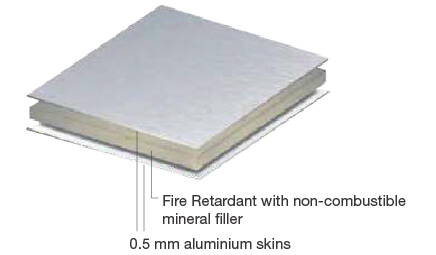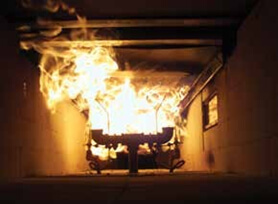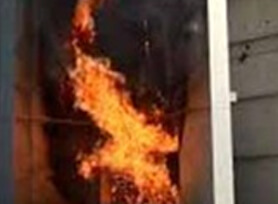Understanding Fire Retardancy
Fire protection for your building begins at the planning stage.
Minimizing fire risk, particularly in places with significant human traffic such as major sporting arenas, mass transit terminals, hospitals, schools and high-rise buildings has become increasingly complex and challenging.
Globally, architects and building owners are required to meet stringent regulations aimed at protecting inhabitants and visitors but also building a structure and surrounding environment from fire hazards, but irrespective of the regulations it is imperative for the users to choose the right grade of building materials which can minimize the damage to human lives and the structure.
A lot depends on using the right kind of products and systems, and utmost care has to be taken in choosing the right grade of Fire Retardant (FR) Aluminium Composite Materials (ACP) so as to mitigate the risk caused by fire. (Illustration on Page 3 shows the fire propagation in case of fire in a building).
It is important to understand the difference between Fire Rating and Fire Retardancy. Any product could have some degree of Fire Rating but that does not necessarily make it Fire Retardant.
Usually, the products and systems have a reaction to fire and resistance to fire, in a certain way. It is essential to look at these both, and the factors that influence the performance of a Fire Retardant cladding solution in totality and not in isolation.
These performance criteria are :
- Lateral and Vertical spread of fire
- Smoke emission
- Droplets
- Self-extinction of fire on the ACP
Therefore, it is key to choose the right product and system in terms of performance in case of fire. But it is equally important to specify the right test methodology and standards to ensure selection of a ‘true’ Fire Retardant facade. The right test methodology has to be ideally a combination of product test like EN 13501-1 along with an intermediate-scale multi story test like NFPA 285 or BS 8414 which addresses most of the key performance criteria mentioned above.
WHY PIONEER FORBID FIRE PANELS B1?

More than ever, buildings of the future not only have to comply with the highest demands on design, they also have to meet the latest technical requirements such as sustainability, energy efficiency and most importantly
– fire protection.
FIRE- safety, PIONEER FORBID FIRE ACP B1 set new standards for cladding materials with certified and proven fire retardancy characteristics.
PIONEER FORBID FIRE ACP B1 is the ‘true’ Fire Retardant Aluminium Composite Materials that you have been looking for.
PIONEER FORBID FIRE PANELS
PIONEER FORBID FIRE PANELS has been developed exclusively for the more stringent fire prevention regulations in architectural products.
Thanks to its mineral-filled core PIONEER FORBID FIRE PANELS meets the stricter requirements of most fire classifications. Its is hardly inflammable and offers all the proven product properties of the PIONEER family, such as flatness, formability, resistance to weather and easy processing.


|
Panel Thickness |
Standards |
Units |
3 mm |
4 mm |
|
|
Thickness of Aluminium Layers Weight |
[mm] [kg/m²] |
0.50 |
|||
|
5.00 |
6.95 |
||||
|
Technical Properties Section Modulus W Rigidity (Poisson's ratio µ = 0,3) E·I Alloy / Temper Modulus of Elasticity Tensile Strength of Aluminium 0.2% Proof Stress Elongation Linear Thermal Expansion |
DIN 53293 DIN 53293 EN 573-3 EN 515 EN 1999 1-1 EN 485-2 EN 485-2 EN 485-2 EN 1999 1-1 |
[cm³/m] [kNcm²/m]
[N/mm²] [N/mm²] [N/mm²] [%] |
1.25 1250 |
1.75 2400 |
2.75 5900 |
|
EN AW-3003 H-16 70'000 Rm ≥ 140 Rp0,2 ≥ 90 A50 ≥ 5 2,4 mm / m at 100°C temperature difference |
|||||
|
Core Mineral filled polymer |
|||||
|
Surface Lacquering Gloss (initial value) Pencil Hardness |
EN 13523-2 EN 13523-4 |
[%] |
Coil Coating PVDF 30 – 80 MIN. HB |
||
|
Thermal Properties Thermal Resistance R sTemperature Resistance |
ASTM C518 |
[m²K/W] [°C] |
0.007 |
0.009 |
0.0172 |
|
-50 to +80 |
|||||
PIONEER PANELS B1
PIONEER FORBID FIRE PANELS B1 is the first non-combustible aluminium composite panel used in architecture that fulfils the respective standards worldwide. Thanks to its mineral core, PIONEER_ B1 meets the strict requirements of some of the toughest fire regulations while retaining the possibilities for the concept
and design of buildings. PIONEER_ B1 just like all the products of the PIONEER_ family, allows simple processing, is impact-resistant, breakproof and weatherproof and, above all, non-combustible.

|
Test accord. to... |
Classification
|
|
|
AS 3837 AS 1530-3 AS ISO 9705
|
Group 1 material BCA Group 3 material no ignition
|
|
|
GB 8624-2006 |
Class B, s1,d0, t0
|
|
|
EN 13501-1 |
Class B, s1, d0
|
|
|
EN 1187 (method 1)/ DIN 4102-7
|
passed |
|
|
BS 476, Part 6 |
Class 0
|
|
|
BS 476, Part 7 |
Class 1
|
|
|
Approved for outdoor wall cladding of any type of building without height limit
|
||
|
EN 13501-1 |
Class B, s1, d0
|
|
|
NFPA 285 |
passed
|
|
|
Approved for outdoor wall cladding of any type of building without height limit
|
|
|
|
ASTM-E-84 |
Class A
|
|
|
BS 476, Part 6&7 |
Class 0
|
|
|
BS 476, Part 6&7 |
Class 0
|
|
|
ASTM-E 84 |
Class A
|
|
|
NFPA 285 |
passed
|
|
Pioneer Forbid Fire Panels (Fire Retardant)

Depending On The Materials Used!
- Plastic foam insulation
- Stone wool insulation
- Glass wool insulation
- Timber/ Wood
- Concrete or other Cement based products
- Stone
- Plastics
- GRP
- Glass
- Metal
Aluminium Composite Materials So the main determinants
We Are Interested In Fire Retardancy, Not Fire Rating
- FR stands for Fire RETARDANCY or Fire RETARDANT
- Many people use Fire RATED
- Anything is fire rated, even combustible materials, e.g. paper, most plastics, etc.
- Any material’s fire rating can be assessed
- Only a material rated as “fire retardant” or “non-combustible” is actually of help in case of a fire
Let’s Understand Some Of The Commonly Requested Qualification Tests

ASTM E-84
This test measures the distance of the flame spread and the light obscuration of the smoke development during a specific time period.

BS 476 – Part 6&7
This test measures the speed and the distance of the flame spread in a specific time period.

NFPA 285
This test method evaluates the inclusion of combustible components within wall assemblies/panels that are required to be of noncombustible construction. Its a simulation of the multistory flammability fire performance of entire exterior wall assemblies

BS 8414-1
This test assess the behaviour of a non-load bearing external cladding system.
The test measures fire spread and classifies based on 3 distinct ways: external fire spread, internal fire spreads and mechanical performances.

EN 13501-1
This test measures the spread of flame and contribution to fire as well the generation of smoke and the production of burning droplets.
| COMMONLY ASKED TESTS | FLAME SPREAD | SMOKE EMISSION | BURNING DROPLETS | SELF EXTINGUISHING | WITH SYSTEM |
| ASTM E-84 | ✓ | ✓ | x | x | x |
| BS 476: part 6&7 | ✓ | x | x | x | x |
| EN 13501-1 | ✓ | ✓ | ✓ | x | x |
| NFPA 285 | ✓ | x | x | ✓ | ✓ |
| BS 8414-1 | ✓ | ✓ | x | ✓ | ✓ |

